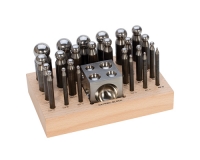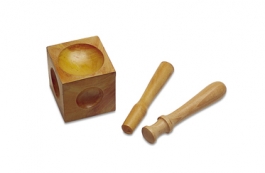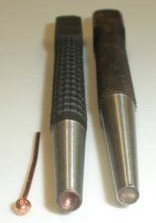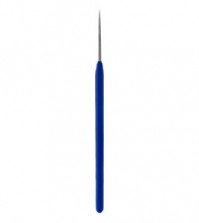- NEW DVD Series – Stone Setting with Bezels
- Tube Set Charm by Kim St. Jean
- Prong Basket Pendant by Kim St. Jean
- NEW DVD Series – Stone Setting with Cold Connections
- New DVD Series – Stone Setting with Wire
- NEW DVD Series: Introduction to Stone Setting by Kim St. Jean
- Featured Tool: Bracelet Bending Plier
- NEW Dvd by Eva Sherman
- Fun, Fast Fold Forming DVD Series
- Double Band Ear Cuff from Alex Simkin
Featured Tool Mar. 18: Deluxe Dapping Set, #DAP-705.00
by Rose Marion, Wire-Sculpture.com
Tool of the Week for March 18, 2013
This week’s tool: Deluxe Dapping Set, 25 Pieces, #DAP-705.00
Video by Kate, JewelryTools.com
| This week’s featured tool from JewelryTools.com is the Deluxe Dapping Set, 25 Pieces, DAP-705.00.
There are 2 types of dapping sets: wooden dapping blocks and steel dapping blocks, with the corresponding punches. These dapping sets will both help you dome metal, but in different ways. Wooden dapping sets give a more gradual dome on metal, and they help to preserve any texture or patterns you’ve added to the metal. Steel dapping sets have more sizes to choose from, and create a bolder dome, and if you have a design on your metal, you may want to lay a thin piece of leather or cloth in the well to preserve the embellishment. Steel sets will also last longer! In both types of dapping sets, you’ll find the same tools: a dapping block, and dapping punches. Simply slip a piece of metal, such as copper blanks, into the well, and then rest the punch on the blank. Then strike the punch with a hammer (nylon or a chasing hammer, if it’s a wood punch. use a brass hammer if it’s a metal set, like this steel set.). Tap all the way around, at an angle, to get your nice dome. Remember to use the right size well for your project. The well should be quite a lot larger than your metal to get a nice curve, especially if the metal is thick. |
Click here to see the Deluxe Dapping Set, 25 Pieces Click here to see a Wooden Dapping Block on Wire-Sculpture.com: Helpful Dapping Terms:
|
Click to Receive Daily Tips by Email

























0 comments